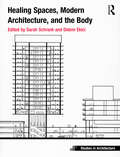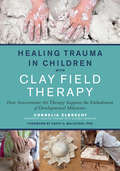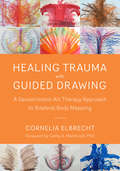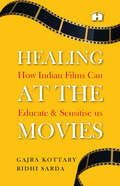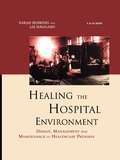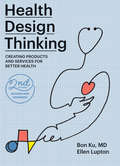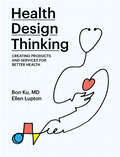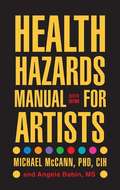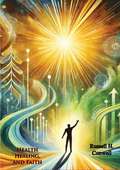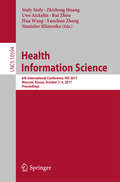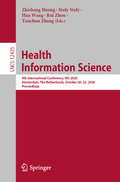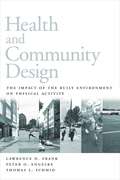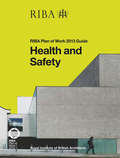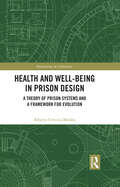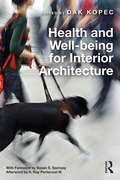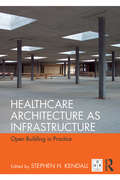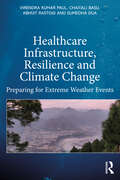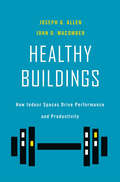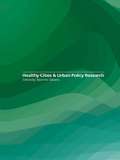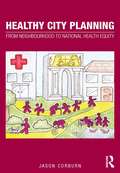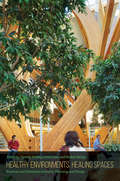- Table View
- List View
Healing Journeys with the Black Madonna: Chants, Music, and Sacred Practices of the Great Goddess
by Alessandra BelloniAn experiential guide to the ancient healing rituals of the Black Madonna • Reveals the practices and rites of the still-living cult of the Black Madonna in the remote villages of Southern Italy, including the healing rites of the tarantella dance • Details shamanic chants, rhythms, and songs and how to use them for self-healing, transformation, and recovery from abuse, trauma, depression, and addiction • Explores the many sacred sites of the Madonnas and connects them to other Great Goddesses, such as Isis, Aphrodite, Cybeles, and the Orisha Yemanja and Ochun • Includes access to 12 audio tracks The mysteries of the Black Madonna can be traced to pre-Christian times, to the ancient devotion to Isis, the Earth Goddess, and the African Mother, to the era when God was not only female but also black. Sacred sites of the Black Madonna are still revered in Italy, and, as Alessandra Belloni reveals, the shamanic healing traditions of the Black Madonna are still alive today and just as powerful as they were millennia ago. Sharing her more than 35 years of research and fieldwork at sacred sites around the world, Belloni takes you on a mystical pilgrimage of empowerment, initiation, and transformation with the Black Madonna. She explains how her love for Italian folk music led her to learn the ancient tammorriata musical tradition of the Earth Goddess Cybele and the Moon Goddess Diana and discover the still-living cult of the Black Madonna in the remote villages of Southern Italy. She vividly describes the sensual shamanic drumming and ecstatic trance dance rituals she experienced there, including the rites of the tammorriata, the transgender rite of Femminielli, and the erotic “spider dance” of the tarantella, which has been used for centuries in the Mediterranean for healing. Sharing chants, rhythms, and sacred songs, she details how she uses these therapeutic musical and trance practices to heal women and men from abuse, trauma, depression, and addiction and shows how these practices can be used for self-healing and transformation, including her personal story of using the tarantella to overcome cervical cancer. Revealing the profound transformative power of the Black Madonna, Belloni shows how She is the womb of the earth, the dark side of the moon, and the Universal Mother to all. Truly alive for all to call upon, She embraces and gives everyone access to Her divine strength and unconditional love.
Healing Spaces, Modern Architecture, and the Body (Ashgate Studies in Architecture)
by Sarah Schrank Didem EkiciHealing Spaces, Modern Architecture, and the Body brings together cutting-edge scholarship examining the myriad ways that architects, urban planners, medical practitioners, and everyday people have applied modern ideas about health and the body to the spaces in which they live, work, and heal. The book’s contributors explore North American and European understandings of the relationship between physical movement, bodily health, technological innovation, medical concepts, natural environments, and architectural settings from the nineteenth century through the heyday of modernist architectural experimentation in the 1920s and 1930s and onward into the 1970s. Not only does the book focus on how professionals have engaged with the architecture of healing and the body, it also explores how urban dwellers have strategized and modified their living environments themselves to create a kind of vernacular modernist architecture of health in their homes, gardens, and backyards. This new work builds upon a growing interdisciplinary field incorporating the urban humanities, geography, architectural history, the history of medicine, and critical visual studies that reflects our current preoccupation with the body and its corresponding therapeutic culture.
Healing Trauma in Children with Clay Field Therapy: How Sensorimotor Art Therapy Supports the Embodiment of Developmental Milestones
by Cornelia ElbrechtThe first book of its kind on treating trauma in children through creative play with clay, written by a leading voice in the field of art therapy.From the moment we&’re born, we rely on our hands to perceive the world. It&’s through touch that we communicate with our primary caregivers and attain an abiding sense of love and security. In Clay Field therapy, client children work with clay and water in a rectangular box. The therapeutic focus is not on object creation, but on the touch connection with the clay as a symbolic external world. Movement, touch, and sensory feedback that have long been out of reach are actualized through the creative process, enabling the child to heal past wounds and regain a more fulfilling sense of self.Author and therapist Cornelia Elbrecht has been a leader in groundbreaking art therapy techniques for over 40 years. In Healing Trauma in Children with Clay Field Therapy, she shows how embodied expression within the Clay Field can be an effective tool in treating children suffering the mental, emotional, and physical effects of trauma. She discusses the theory and practice of Clay Field therapy using dozens of case examples and more than 200 images. Working within a fun, safe, and trusting environment, children respond with their embodied braced, chaotic, or dissociated structures of the past, but are then able to foster new sensorimotor experiences that enhance self-esteem, empowerment, and a restoration of developmental deficits. Child therapists will find this book to be a valuable tool--working with a Clay Field can reach even the earliest developmental trauma events, repairing their damage through the haptic hands-brain connection.
Healing Trauma with Guided Drawing: A Sensorimotor Art Therapy Approach to Bilateral Body Mapping
by Cornelia ElbrechtA body-focused, trauma-informed art therapy that will appeal to art therapists, somatic experiencing practitioners, bodyworkers, artists, and mental health professionalsWhile art therapy traditionally focuses on therapeutic image-making and the cognitive or symbolic interpretation of these creations, Cornelia Elbrecht instructs readers how to facilitate the body-focused approach of guided drawing. Clients draw with both hands and eyes closed as they focus on their felt sense. Physical pain, tension, and emotions are expressed without words through bilateral scribbles. Clients then, with an almost massage-like approach, find movements that soothe their pain, discharge inner tension and emotions, and repair boundary breaches. Archetypal shapes allow therapists to safely structure the experience in a nonverbal way. Sensorimotor art therapy is a unique and self-empowering application of somatic experiencing--it is both body-focused and trauma-informed in approach--and assists clients who have experienced complex traumatic events to actively respond to overwhelming experiences until they feel less helpless and overwhelmed and are then able to repair their memories of the past. Elbrecht provides readers with the context of body-focused, trauma-informed art therapy and walks them through the thinking behind and process of guided drawing--including 100 full-color images from client sessions that serve as helpful examples of the work.
Healing at the Movies: How Indian Films Can Educate and Sensitise Us
by Gajra Kottary Ridhi Ridhi SardaPopcorn tub ready. Phone on silent. Back reclined. Lights dim. Let the magic begin!The Indian cinema has a power over us like no other. Be it the cast, the songs, the story, or the message, film-viewing as an experience is much more than just for &‘entertainment, entertainment, and entertainment&’. Be it a good movie or bad, we love to discuss, debate, and analyse. There is no denying that they stay with us for a long time, because bade-bade deshon mein aisi chhoti-chhoti baatein hoti rehti hain.Healing at the Movies is a book about cinema and its impact on us. Apart from the glitz, the glamour, and the sparkle, films can subconsciously influence our thoughts and how we react to situations in life. The three uninterrupted hours that we give, we share each character&’s pain and problems as much as their joys and celebrations. This is where reality and fiction merge together . . . where a song and dance sequence can teach us more about society than society itself. *Cue the song: Khalbali hai khalbali*Every film is a reflection of its times. This book is a treasure trove of movies made on pertinent social issues that will not only rekindle your love for the Indian cinema but also make you a better, informed human being. So, what are you waiting for? Picture abhi baaki hai mere dost ...
Healing the Hospital Environment: Design, Management and Maintenance of Healthcare Premises
by Liz Haggard Sarah HoskingHealing the Hospital Environment identifies why many healthcare premises do not look or feel welcoming and why even well-intentioned efforts to make improvements are unsuccessful.The authors show that significant improvements can be made within limited resources if hospitals recognise what can be achieved, set standards and invest in the relevant design expertise. It gives a wide range of examples of effective improvement in design, maintenance and management of all types of hospital and healthcare premises and their surrounding land.
Health Design Thinking, second edition: Creating Products and Services for Better Health
by Ellen Lupton Bon KuA practice-based guide to applying the principles of human-centered design to real-world health challenges; updated and expanded with post–COVID-19 innovations. This book offers a practice-based guide to applying the principles of human-centered design to real-world health challenges that range from drug packaging to breast cancer detection. Written by pioneers in the field—Bon Ku, a physician leader in innovative health design, and Ellen Lupton, an award-winning graphic designer—the book outlines the fundamentals of design thinking and highlights important products, prototypes, and research in health design. This revised and expanded edition describes innovations developed in response to the COVID-19 crisis, including an intensive care unit in a shipping container, a rolling cart with intubation equipment, and a mask brace that gives a surgical mask a tighter seal. The book explores the special overlap of health care and the creative process, describing the development of such products and services as a credit card–sized device that allows patients to generate their own electrocardiograms; a mask designed to be worn with a hijab; improved emergency room signage; and a map of racial disparities and COVID-19. It will be an essential volume for health care providers, educators, patients, and designers who seek to create better experiences and improved health outcomes for individuals and communities.
Health Design Thinking: Creating Products and Services for Better Health
by Ellen Lupton Bon KuApplying the principles of human-centered design to real-world health care challenges, from drug packaging to early detection of breast cancer.This book makes a case for applying the principles of design thinking to real-world health care challenges. As health care systems around the globe struggle to expand access, improve outcomes, and control costs, Health Design Thinking offers a human-centered approach for designing health care products and services, with examples and case studies that range from drug packaging and exam rooms to internet-connected devices for early detection of breast cancer. Written by leaders in the field—Bon Ku, a physician and founder of the innovative Health Design Lab at Sidney Kimmel Medical College, and Ellen Lupton, an award-winning graphic designer and curator at Cooper Hewitt Smithsonian Design Museum—the book outlines the fundamentals of design thinking and highlights important products, prototypes, and research in health design.Health design thinking uses play and experimentation rather than a rigid methodology. It draws on interviews, observations, diagrams, storytelling, physical models, and role playing; design teams focus not on technology but on problems faced by patients and clinicians. The book's diverse case studies show health design thinking in action. These include the development of PillPack, which frames prescription drug delivery in terms of user experience design; a credit card–size device that allows patients to generate their own electrocardiograms; and improved emergency room signage. Drawings, photographs, storyboards, and other visualizations accompany the case studies.Copublished with Cooper Hewitt, Smithsonian Design Museum
Health Hazards Manual for Artists
by Michael Mccann Angela BabinThis is the trusted resource for working artists and art students written by the leading authority on health hazards. Whether you work in painting, photography, sculpture, ceramics, printmaking, woodworking, textiles, computer, or children s art, this is the only reference book that covers all the dangers associated with metals, minerals, and chemicals. This first aid book shows how to treat injuries and work with proper caution while still being creative. Updates include new ventilation, photo processing, and computer systems. Whether you are a beginner or professional, this is a must for every school, art studio, and home.
Health Healing, and Faith: Effective Prayer
by Russell H. ConwellRussell H. Conwell’s "Health, Healing, and Faith" is a profound exploration of the interconnectedness between physical well-being, spiritual health, and the power of faith. Conwell, a renowned Baptist minister, lawyer, and founder of Temple University, delves into the principles and practices that contribute to a holistic approach to health and healing.In this insightful work, Conwell presents a compelling case for the importance of maintaining a healthy body, mind, and spirit. He draws on his extensive knowledge and experience to provide readers with practical advice on how to achieve and sustain overall wellness through a balanced lifestyle and a strong spiritual foundation.Key themes include:Holistic Health: Conwell emphasizes the significance of a holistic approach to health, which encompasses physical, mental, and spiritual well-being. He advocates for a balanced diet, regular exercise, and mental relaxation as essential components of physical health.Spiritual Healing: The book explores the role of faith and spirituality in the healing process. Conwell shares inspiring stories of individuals who have experienced miraculous recoveries through the power of prayer and unwavering faith.Mind-Body Connection: Conwell highlights the profound impact of mental and emotional states on physical health. He offers practical techniques for managing stress, fostering positive thinking, and cultivating inner peace to promote overall wellness.Faith and Medicine: "Health, Healing, and Faith" bridges the gap between faith and medicine, encouraging readers to integrate spiritual practices with medical treatments. Conwell believes that a strong faith can complement and enhance traditional medical approaches.Conwell’s compassionate and accessible writing style makes complex concepts easy to understand, providing readers with actionable steps to improve their health and well-being. His holistic philosophy encourages a harmonious integration of body, mind, and spirit, empowering individuals to take control of their health journey.Whether you are looking to improve your physical health, deepen your spiritual practice, or find inner peace, "Health, Healing, and Faith" provides the inspiration and tools to help you on your path to holistic well-being.
Health Information Science: 6th International Conference, HIS 2017, Moscow, Russia, October 7-9, 2017, Proceedings (Lecture Notes in Computer Science #10594)
by Siuly Siuly, Zhisheng Huang, Uwe Aickelin, Rui Zhou, Hua Wang, Yanchun Zhang and Stanislav KlimenkoThis book constitutes the refereed proceedings of the 6th International Conference on Health Information Science, HIS 2017, held in Moscow, Russia, in October 2017.The 11 full papers and 7 short papers presented were carefully reviewed and selected from 44 submissions. The papers feature multidisciplinary research results in health information science and systems that support health information management and health service delivery. They relate to all aspects of the conference scope, such as medical/health/biomedicine information resources such as patient medical records, devices and equipments, software and tools to capture, store, retrieve, process, analyze, and optimize the use of information in the health domain; data management, data mining, and knowledge discovery, management of publichealth, examination of standards, privacy and security issues; computer visualization and artificial intelligence for computer aided diagnosis; development of new architectures and applications for health information systems.
Health Information Science: 9th International Conference, HIS 2020, Amsterdam, The Netherlands, October 20–23, 2020, Proceedings (Lecture Notes in Computer Science #12435)
by Yanchun Zhang Hua Wang Siuly Siuly Rui Zhou Zhisheng HuangThis book constitutes the proceedings of the 9th International Conference on Health Information Science, HIS 2020, which took place in Amsterdam, The Netherlands, during October 20-23, 2020. The 11 full papers and 6 short papers presented in this volume were carefully reviewed and selected from 62 submissions. They were organized in topical sections named: mental health; medical record processing; medical information systems; medical diagnosis with machine learning; and health behavior and medication.
Health and Community Design: The Impact Of The Built Environment On Physical Activity
by Peter Engelke Lawrence Frank Thomas SchmidHealth and Community Design is a comprehensive examination of how the built environment encourages or discourages physical activity, drawing together insights from a range of research on the relationships between urban form and public health. It provides important information about the factors that influence decisions about physical activity and modes of travel, and about how land use patterns can be changed to help overcome barriers to physical activity. Chapters examine:* the historical relationship between health and urban form in the United States * why urban and suburban development should be designed to promote moderate types of physical activity * the divergent needs and requirements of different groups of people and the role of those needs in setting policy * how different settings make it easier or more difficult to incorporate walking and bicycling into everyday activitiesA concluding chapter reviews the arguments presented and sketches a research agenda for the future.
Health and Safety: RIBA Plan of Work 2013 Guide
by Peter CaplehornHealth and Safety is part of a brand new series providing must-read practical guidance to running efficient and successful projects using the new RIBA Plan of Work 2013. Each guide takes a core project activity – in this case those associated with managing and integrating health and safety - and explains the essential activities required at each stage. Concise and easy to use with a consistent format these guides provide the ultimate quick reference support at your desk or on-site. An authoritative ‘how to’ full of pragmatic advice, examples and in-text features such as ‘hints and tips’ that illuminate best practice and clever solutions. Designed to be used on all projects – large and small – and across all types of procurement, they are task rather than role-oriented acknowledging that a variety of people take on these responsibilities. They are also invaluable for architectural students at Part 3 who are getting to grips with the realities of practice.
Health and Well-Being in Prison Design: A Theory of Prison Systems and a Framework for Evolution (Innovations in Corrections)
by Alberto Urrutia-MoldesThis book establishes a new framework for prison design to promote the health and well-being of all prison users. Based on international research in Norway, Finland, the US and Chile, and drawing on the expertise of key International Advisors, this book uniquely reveals the perspectives of both designers and prison authorities concerning well-being in prison architecture. It is the first book to compare perspectives between prison models while providing essential guidance for the design of prison environments to promote the rehabilitation of inmates and their desistance from crime. The promotion of health and well-being of people in prison is vital to enable rehabilitation. Traditional prison architecture severely weakens both rehabilitation efforts and opportunities for desistance. Only a handful of prison systems in the world have shown significant changes in their prison designs. Underpinned by Critical Realism and the PERMA theory of well-being, this book reveals significant new insights to inform prison design. The author presents international case study research with interviews with prison authorities and designers from four countries and the three different prison models, as well as key international United Nations advisors. For the first time the visions of prison designers are contrasted with those of prison authorities, bringing a new synthesised understanding of the differences and similarities in their approach to the health and well-being of both inmates and staff from which to generate a new framework for design considerations. This book illuminates new directions for prison design and is essential reading for policymakers, academics, and students involved in the study and development of criminology, corrections, and penology. It is also an indispensable source of up-to-date knowledge for prison authorities, public health officials, architects, and designers involved in the design of prisons and any other type of coercive detention facilities.
Health and Well-being for Interior Architecture
by Dak KopecWith fifteen essays by scholars and professionals, from fields such as policy and law, Health and Well-being for Interior Architecture asks readers to consider climate, geography, and culture alongside human biology, psychology, and sociology. Since designers play such a pivotal role in human interaction with interior and architectural design, this book sheds light on the importance of a designer’s attention to health and well-being while also acknowledging the ever changing built environment. Through various viewpoints, and over 30 images, this book guides designers through ways to create and develop interior designs in order to improve occupants’ health and well-being.
Healthcare Architecture as Infrastructure: Open Building in Practice (Open Building)
by Stephen H. KendallArchitects and healthcare clients are increasingly coming to recognize that, once built, healthcare facilities are almost immediately subject to physical alterations which both respond to and affect healthcare practices. This calls into question the traditional ways in which these facilities are designed. If functions and practices are subject to alteration, the standard approach of defining required functions and practices before acquiring facilities is obsolete. We need other starting points, working methods, and ways of collaborating. Healthcare Architecture as Infrastructure presents these new approaches. Advocating an infrastructure theory of built environment transformation in which design and investment decisions are organized hierarchically and transcend short-term use, the book draws the practice and research of a number of architects from around the world. Written by experts with experience in policy making, designing, building, and managing complex healthcare environments, it shows professionals in architecture, engineering, healthcare and facilities management how to enhance the long-term usefulness of their campuses and their building stock and how to strengthen their physical assets with the capacity to accommodate a quickly evolving healthcare sector.
Healthcare Design Basics
by Mark Karlen Saglinda H. Roberts Kyra K. TuckerHEALTHCARE DESIGN BASICS An approachable and robust treatment of designing and planning spaces for use in healthcare settings In Healthcare Design Basics, a team of distinguished interior architecture practitioners and educators delivers an up-to-date text covering the critical aspects of healthcare design, preparing students for a specialty rapidly growing in importance and size. The book adopts an approach designed to crystalize the most important elements of broad range of ambulatory facilities for healthcare design students and new professionals in a clear, concise, and approachable way. The authors combine a broad overview of numerous ambulatory healthcare typologies with exercises that allow students to prepare detailed plans for many of the most commonly used rooms and typologies in the healthcare industry, thus preparing them for the demands of professional positions. The book also includes: Step by step studio guidance outlining the basic design elements required for a wide range of ambulatory healthcare facilities and rooms Comprehensive explorations of the demands of new and improved healthcare facilities that meet the needs of an aging population Practical discussions of the space planning challenges involved in designing rooms and facilities for use during public health crises, including pandemics Dozens of full-color images that illustrate and highlight important concepts, examples, and design solutions Written for students of interior design, architecture, and emerging professionals, Healthcare Design Basics also benefits professionals tasked with the initial planning and design of ambulatory facilities, and other healthcare settings.
Healthcare Infrastructure, Resilience and Climate Change: Preparing for Extreme Weather Events
by Virendra Kumar Paul Abhijit Rastogi Sumedha Dua Chaitali BasuThis book highlights the vulnerability of healthcare buildings in the context of climate change-triggered extreme weather events (EWEs) and the case for mitigation. With a concise discussion on climate change and its consequences in the form of such events, a cost model and equations that register losses and help quantify them are then presented. The model can be used to estimate the significant potential loss that might occur during an EWE and help healthcare facilities prepare for them. The book analyses cases of major EWEs in India over the last two decades and collates the data available into various categories. Through this research the authors have developed a framework which assists healthcare facilities with a detailed calculation of value losses, both tangible and intangible. The framework can be used to assess the impacts on healthcare buildings in terms of disruption of services so that appropriate decisions related to the resilience in healthcare planning can be taken into consideration. Thus, the book is useful for directing planning and design processes aimed at continuity of service and building resilience to perform in the face of natural disaster and extreme weather. The purpose of this book is to prompt facilities planners and healthcare facilities to prepare to respond to EWEs through the planning and design process in a rational manner. Built infrastructure professionals such as architects and engineers, policy makers, and academics with an interest in disasters, risk and climate change will all find this book to be key reading.
Healthier Homes: A Blueprint for Creating a Toxin-Free Living Environment
by Jen Stout Rusty StoutMost of us spend 90 percent of our time indoors, but our indoor environments could be causing us significant harm. Everything from flooring to paints to insulation contains chemicals known to contribute to health problems such as cardiovascular disease and cancer. In this book, Jen and Rusty Stout, nationally recognized healthy home building innovators, teach you how to think like a builder so that you can construct a new home or upgrade an existing one to put wellness first. Making smart choices when it comes to building materials, moisture protection, and more can make all the difference in reducing your family&’s exposure to toxins and living a healthier life.Whether you are a home buyer, a homeowner working with a professional builder, a building contractor, or a DIY-er, Healthier Homes walks you through key considerations such as Site selectionDesigning a living space that meets your family&’s unique needsMaterial choices for the exterior and interiorAir and water qualitySourcing home furnishings and finishesExisting home upgradesMold remediation
Healthy Buildings: How Indoor Spaces Can Make You Sick—or Keep You Well
by John D. Macomber Joseph G. AllenA revised and updated edition of the landmark work the New York Times hailed as “a call to action for every developer, building owner, shareholder, chief executive, manager, teacher, worker and parent to start demanding healthy buildings with cleaner indoor air.”For too long we’ve designed buildings that haven’t focused on the people inside—their health, their ability to work effectively, and what that means for the bottom line. An authoritative introduction to a movement whose vital importance is now all too clear, Healthy Buildings breaks down the science and makes a compelling business case for creating healthier offices, schools, and homes.As the COVID-19 crisis brought into sharp focus, indoor spaces can make you sick—or keep you healthy. Fortunately, we now have the know-how and technology to keep people safe indoors. But there is more to securing your office, school, or home than wiping down surfaces. Levels of carbon dioxide, particulates, humidity, pollution, and a toxic soup of volatile organic compounds from everyday products can influence our health in ways people aren’t always aware of.This landmark book, revised and updated with the latest research since the COVID-19 pandemic, lays out a compelling case for more environmentally friendly and less toxic offices, schools, and homes. It features a concise explanation of disease transmission indoors, and provides tips for making buildings the first line of defense. Joe Allen and John Macomber dispel the myth that we can’t have both energy-efficient buildings and good indoor air quality. We can—and must—have both. At the center of the great convergence of green, smart, and safe buildings, healthy buildings are vital to the push for more sustainable urbanization that will shape our future.
Healthy Buildings: How Indoor Spaces Drive Performance and Productivity
by John D. Macomber Joseph G. Allen“This book should be essential reading for all who commission, design, manage, and use buildings—indeed anyone who is interested in a healthy environment.” —Norman Foster A forensic investigator of “sick buildings” and Director of Harvard’s Healthy Buildings Program teams up with a CEO-turned–Harvard Business School professor to reveal the secrets of a healthy building—and unlock one of the greatest business opportunities of our time. By the time you reach eighty, you will have spent seventy-two years of your life indoors. Like it or not, humans have become an indoor species. This means that the people who design, build, and maintain our buildings can have a major impact on our health. Ever feel tired during a meeting? That’s because most offices and conference rooms are not bringing in enough fresh air. When that door opens, it literally breathes life back into the room. But there is a lot more acting on your body that you can’t feel or see. From our offices and homes to our schools and hospitals, the indoor spaces where we work, learn, play, eat, and heal have an outsized influence on our performance and wellbeing. They affect our creativity, focus, and problem-solving ability and can make us sick—dragging down profits in the process. Charismatic pioneers of the healthy building movement who have paired up to combine the cutting-edge science of Harvard’s School of Public Health with the financial know-how of the Harvard Business School, Joseph Allen and John Macomber lay out the science of healthy buildings and make the business case for owners, developers, and CEOs. They reveal the 9 Foundations of a Healthy Building, and show how tracking health performance indicators with smart technology can boost performance and create economic value. While the “green” building movement tackled energy, waste, and water, the new healthy building movement focuses on the most important (and expensive) asset of any business: its people.
Healthy Cities and Urban Policy Research
by Takehito TakanoHealthy Cites and Urban Policy Research is a collection of papers by leading experts from academia or international organisations who have been involved in the Healthy Cities Movement. It is the first academic work to combine public health with urban planning. Contemporary issues from various perspectives are included which address evaluation, evidence-based practice, accountability, community participation and information technology.
Healthy City Planning: From Neighbourhood to National Health Equity (Planning, History and Environment Series)
by Jason CorburnHealthy city planning means seeking ways to eliminate the deep and persistent inequities that plague cities. Yet, as Jason Corburn argues in this book, neither city planning nor public health is currently organized to ensure that today’s cities will be equitable and healthy. Having made the case for what he calls ‘adaptive urban health justice’ in the opening chapter, Corburn briefly reviews the key events, actors, ideologies, institutions and policies that shaped and reshaped the urban public health and planning from the nineteenth century to the present day. He uses two frames to organize this historical review: the view of the city as a field site and as a laboratory. In the second part of the book Corburn uses in-depth case studies of health and planning activities in Rio de Janeiro, Nairobi, and Richmond, California to explore the institutions, policies and practices that constitute healthy city planning. These case studies personify some of the characteristics of his ideal of adaptive urban health justice. Each begins with an historical review of the place, its policies and social movements around urban development and public health, and each is an example of the urban poor participating in, shaping, and being impacted by healthy city planning.
Healthy Environments, Healing Spaces: Practices and Directions in Health, Planning, and Design
by Timothy Beatley, Carla Jones, and Reuben RaineyThis collection of essays by leading scholars and practitioners addresses a timely and essential question: How can we design, plan, and sustain built environments that will foster health and healing? With a salutogenic (health-promoting) focus, Healthy Environments, Healing Spaces addresses a range of contemporary issues, including health equity, biophilic cities, healthcare facility design, environmental health, aging in place, and food systems planning.Contributors: Ellen Bassett ● Timothy Beatley ● Emily Chmielewski ● Jason Corburn ● Tanya Denckla Cobb ● Tye Farrow ● Ann Forsyth ● Howard Frumkin ● Judith H. Heerwagen ● J. David Hoglund ● Carla Jones ● Andrew Mondschein ● Christina Mullen ● Reuben Rainey ● Samina Raja ● Jennifer Whittaker

